
A diatom is any member of a large group comprising several genera of algae, specifically microalgae, found in the oceans, waterways and soils of the world. Living diatoms make up a significant portion of the Earth's biomass: they generate about 20 to 50 percent of the oxygen produced on the planet each year, take in over 6.7 billion tonnes of silicon each year from the waters in which they live, and constitute nearly half of the organic material found in the oceans. The shells of dead diatoms can reach as much as a half-mile deep on the ocean floor, and the entire Amazon basin is fertilized annually by 27 million tons of diatom shell dust transported by transatlantic winds from the African Sahara, much of it from the Bodélé Depression, which was once made up of a system of fresh-water lakes.
In biology, setae are any of a number of different bristle- or hair-like structures on living organisms.
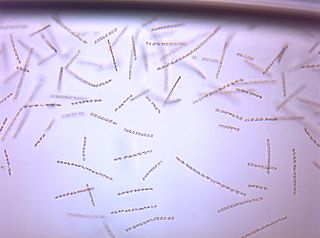
Chaetocerotaceae is a diatom family (Bacillariophyta). This family comprise the three genera Attheya T. West, Bacteriastrum Shadbolt and Chaetoceros Ehrenberg. Chaetoceros is perhaps the largest and most species rich genus of marine planktonic diatoms. The taxonomic status within Chaetocerotaceae at present is somewhat unclear.

Chaetoceros is a genus of diatoms in the family Chaetocerotaceae, first described by the German naturalist C. G. Ehrenberg in 1844. Species of this genus are mostly found in marine habitats, but a few species exist in freshwater. It is arguably the common and most diverse genus of marine planktonic diatoms, with over 200 accepted species. It is the type genus of its family.

Chaetoceros furcellatus is an Arctic neritic diatom in the genus Chaetoceros. The easiest way to identify this species is by finding the very characteristic resting spores. C. furcellatus is a common and important species in the Barents sea.
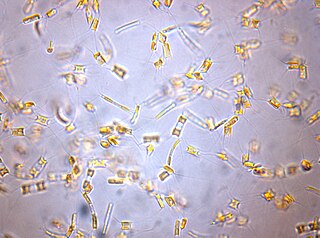
Attheya is a genus of small single celled diatoms. Some of these species were earlier regarded to belong to Chaetoceros, or to Gonioceros, the taxonomic status of some of these species are still debated.
Attheya arenicola is a diatom in the genus Attheya. Type material was collected from intertidal sand in Penbre, South Wales.
Attheya armata is a species of diatoms in the genus Attheya.
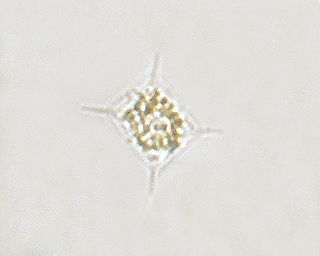
Attheya decora is a species of diatoms in the genus Attheya. Type material was collected from Cresswell sands, Northumberland by Mr. Atthey.
Attheya flexuosa is a species of diatoms in the genus Attheya. Type material was collected from Benllech, Gwynedd, North Wales in UK on intertidal sand.

Attheya longicornis is a species of diatoms in the genus Attheya. Type material was collected from Penberth, Cornwall in England.

Bacteriastrum is a genus of diatoms in family Chaetocerotaceae. There are more than 30 described species in genus Bacteriastrum, but many of these are not currently accepted, and new species are still added to the genus. The type species for the genus is Bacteriastrum furcatum Shadbolt.
Attheya gaussii is a species of diatoms in the genus Attheya.

Chaetoceros diadema is a diatom in the genus Chaetoceros. The easiest way to identify this species is by finding the very characteristic diadem-like resting spores.
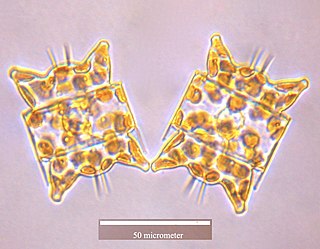
Odontella aurita is a diatom and the type species of genus Odontella. The easiest way to identify this species is by recognizing the very distinct shape of the cells belonging to this genus. Odontella aurita is cultivated industrially for human consumption due to its ability to produce up to 28% of its total lipids as eicosapentaenoic acid (EPA), a long-chain polyunsaturated fatty acid (PUFA). PUFAs such as EPA are known to provide a variety of health benefits in humans, and are commonly obtained by fish oil. However, with the increasing concern of over-exploited fisheries, microalgae are a promising source of PUFAs as they can be grown year-round and their fatty acid profile and content are easily manipulated by growth conditions.

Odontella is a genus of marine diatoms. It contains the following species:

Thalassiosira is a genus of centric diatoms, comprising over 100 marine and freshwater species. It is a diverse group of photosynthetic eukaryotes that make up a vital part of marine and freshwater ecosystems, in which they are key primary producers and essential for carbon cycling
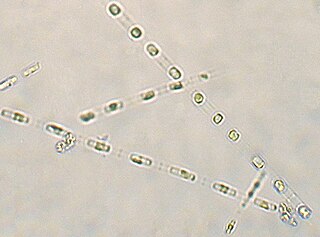
Skeletonema is a genus of diatoms in the family Skeletonemataceae. It is the type genus of its family. The genus Skeletonema was established by R. K. Greville in 1865 for a single species, S. barbadense, found in the Barbados deposit [Jung 2009]. These diatoms are photosynthetic organisms, meaning they obtain carbon dioxide from their surrounding environment and produce oxygen along with other byproducts. Reproduce sexually and asexually [Guiry 2011]. Skeletonema belong to the morphological category referred to as centric diatoms. These are classified by having valves with radial symmetry and the cells lack significant motility [Horner 2002]. Skeletonema are cylindrical shaped with a silica frustule. Cells are joined by long marginal processes to form a filament [Horner 2002]. Their length ranges from 2-61 micrometers, with a diameter ranging from 2-21 micrometers [Hasle 1997]. They are found typically in the neritic zone of the ocean and are highly populous in coastal systems [Jung 2009]. The genus is considered cosmopolitan, showing a wide range of tolerance for salinity and temperature [Hasle 1973]. For example, they have been found in various aquatic environments such as brackish or freshwater. Skeletonema are found worldwide excluding Antarctic waters [Hevia-Orube 2016]. Some harmful effects these diatoms may have on an ecosystem are attributed to large blooming events which may cause hypoxic events in coastal systems. Additionally, they are known to cause water discoloration [Kraberg 2010].

Diatoms belong to a large group called the heterokonts, which include both autotrophs such as golden algae and kelp; and heterotrophs such as water moulds. The classification of heterokonts is still unsettled: they may be designated a division, phylum, kingdom, or something intermediate to those. Consequently, diatoms are ranked anywhere from a class, usually called Diatomophyceae or Bacillariophyceae, to a division (=phylum), usually called Bacillariophyta, with corresponding changes in the ranks of their subgroups.
Chaetoceros coarctatus is a marine, unicellular species of planktonic diatom in the genus Chaetoceros, first described by Lauder in January 1864 using samples from the Hong Kong harbor. Like many diatoms, it is preyed upon by ctenophores. During warming periods of the Mediterranean Sea, this non-native species, first introduced through the Suez Canal, expands its range. Cell chains showcase pairs of posterior and anterior terminal setae, as well as intercalary setae, for anti-predatory mechanical protection and floating benefits. These silica appendages have spines, curved tips, and are longer those on other members of the Chaetoceros genus for higher survival benefits.









